

Introducing Project-Based Learning in your Classroom - Teachers academy. Supporting Deeper Learning in the Classroom – Digital Promise. | by Jennifer Kabaker For today’s students to effectively compete in the global workforce, they must develop the skills, understandings, and mindsets necessary to prepare them for the careers and challenges of tomorrow.
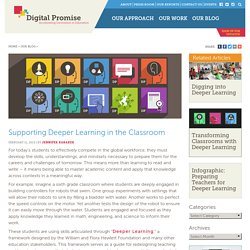
This means more than learning to read and write – it means being able to master academic content and apply that knowledge across contexts in a meaningful way. For example, imagine a sixth grade classroom where students are deeply engaged in building controllers for robots that swim. One group experiments with settings that will allow their robots to sink by filling a bladder with water.
Another works to perfect the speed controls on the motor. These students are using skills articulated through “Deeper Learning,” a framework designed by the William and Flora Hewlett Foundation and many other education stakeholders. Summaries of Learning Theories and Models. The Difference Between Pedagogy, Andragogy, And Heutagogy.
Learning Theories, Learning Models, Learning Theory Summaries - in Plain English! The ABC’s of Competency-Based Learning. Although classrooms offline have been delivering competency-based training for decades, the eLearning industry has only just woken up to the merits of this form of learning.
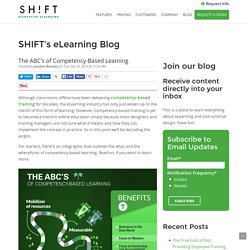
However, competency-based training is yet to become a trend in online education simply because most designers and training managers are not sure what it means and how they can implement the concept in practice. So in this post we’ll be decoding the jargon. For starters, here’s an infographic that outlines the whys and the wherefores of competency-based learning. Read on, if you want to learn more. What is a Competence? On-the-Spot Support: Using the Scaffolding Technique in Your Teaching Approach. When you think about scaffolds, you probably visualize the structures used during construction to support workers and materials.
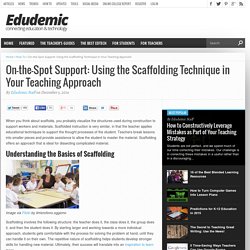
Scaffolded instruction is very similar, in that the teacher applies educational techniques to support the thought processes of the student. Teachers break lessons into smaller pieces and provide assistance to allow the student to master the material. Scaffolding offers an approach that is ideal for dissecting complicated material. Understanding the Basics of Scaffolding Image via Flickr by ilmicrofono.oggiono Scaffolding involves the following structure: the teacher does it, the class does it, the group does it, and then the student does it. PBL / Inquiry / Design Thinking. What is PBL? 5 Characteristics Of Project-Based Learning That Works -
Schedule a TeachThought Professional Development PBL Workshop For Your School >
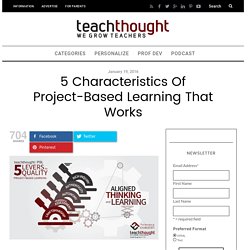
Problem Based Learning at Stenden University. THE SEVEN STEPS OF PBL IMPLEMENTATION: TUTOR'S MANUAL. Blueprints In Health Profession Education Series |PBL Tutor's Manual4 Introduction Problem-BasedLearning(PBL)isaneducationalstrategyintroducedatMcMasterUniversity,Canadain1969.
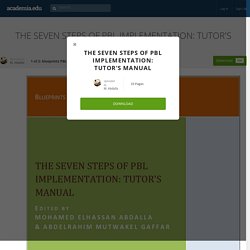
PBLstrategyusespatient'sproblemtomotivatestudentslearning. ManyfactorsaffectthequalityofPBLandthustheacquisitionandretrievalknowledge. Amongthosefactorsare;thequalityoftheproblemconstructionandtutorBehaviour. DrMohamedElhassanAbdall, MedicalEducationUnitFacultyofMedicine–JazanUniversityJazan-KSADrAbdelrahimMutwakelGaffar, FamilyandcommunityMedicineDepartmentFacultyofMedicine–JazanUniversityJazan-KSA. A Depth Of Knowledge Rubric For Reading, Writing, And Math. A Depth Of Knowledge Rubric For Reading, Writing, And Math by Terry Heick This is part 1 in a 3 part “Return To The Classroom” series, so-named because we, somehow, loathe the phrase “Back to School.”
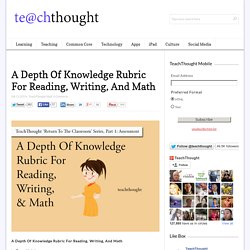
Today’s post is on assessment, with a look at rubrics for the Depth of Knowledge framework. My first three years as a teacher, my district used Norman Webb’s Depth of Knowledge framework. Bloom’s Taxonomy gets most of the press in education, and UbD 6 Facets of Understanding, and Marzano’s New Taxonomy are also useful frameworks for dispersing “cognitive actions,” but it was the “DOK” model that I used first, and so it has a soft spot in my heart. Wildwood Inquiry-Based Learning: Developing Student-Driven Questions. Defining Inquiry Inquiry-based learning, rather than presenting a set of facts, uses student inquiries, questions, interests, and curiosities to drive learning.

This level of student involvement makes the learning more relevant, encouraging students to develop their own agency and critical thinking skills. The Inspiration Wildwood was already using inquiry-based learning to some extent, but things took off for them when, in Principal Mary Beth Cunat's second year, the school put on an Inquiry Fair. The event was similar to a science fair, where students demonstrated their personal inquiries/projects and results, some of which aligned with unit content and some of which drew from their own personal interests. Is 2016 The Year That Progressive Education Returns? - Is 2016 The Year That Progressive Education Returns?
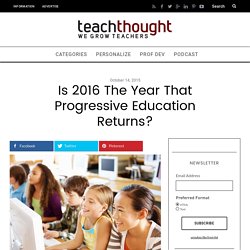
By Robert Sun The 1920’s were a high point in the Progressive Education movement. Developed in response to the rigid pedagogy of 19th Century industrial society—methods that stressed uniform learning largely defined by social class—Progressive Education sought to break the mold with a more enlightened approach to public schooling. While Progressive Education had many elements, it essentially followed three teaching strategies.
First was an emergent curriculum that responded to children’s enthusiasms, recognizing that students are most motivated to learn something they are already interested in. Despite its promise and a number of early successes, Progressive Education eventually lost momentum in the United States. 4 Elements to Effective Adult Learning, According to Neuroscience. Adult Learning or Andragogy highlights that adult learners are fundamentally different in their methods of learning in comparison with children.
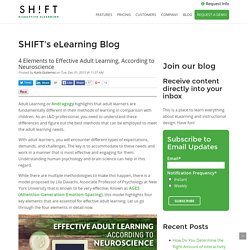
As an L&D professional, you need to understand these differences and figure out the best methods that can be employed to meet the adult learning needs. With adult learners, you will encounter different types of expectations, demands, and challenges. The key is to accommodate to these needs and work in a manner that is most effective and engaging for them. Understanding human psychology and brain science can help in this regard.
While there are multiple methodologies to make this happen, there is a model proposed by Lila Davachi, Associate Professor of Psychology at New York University that is known to be very effective. 1) Attention "Learning that happens while multitasking cannot be generalized— and does not result in understanding or the ability to recall when needed. " Read: The Science of Attention (And Why eLearning Professionals Should Care)